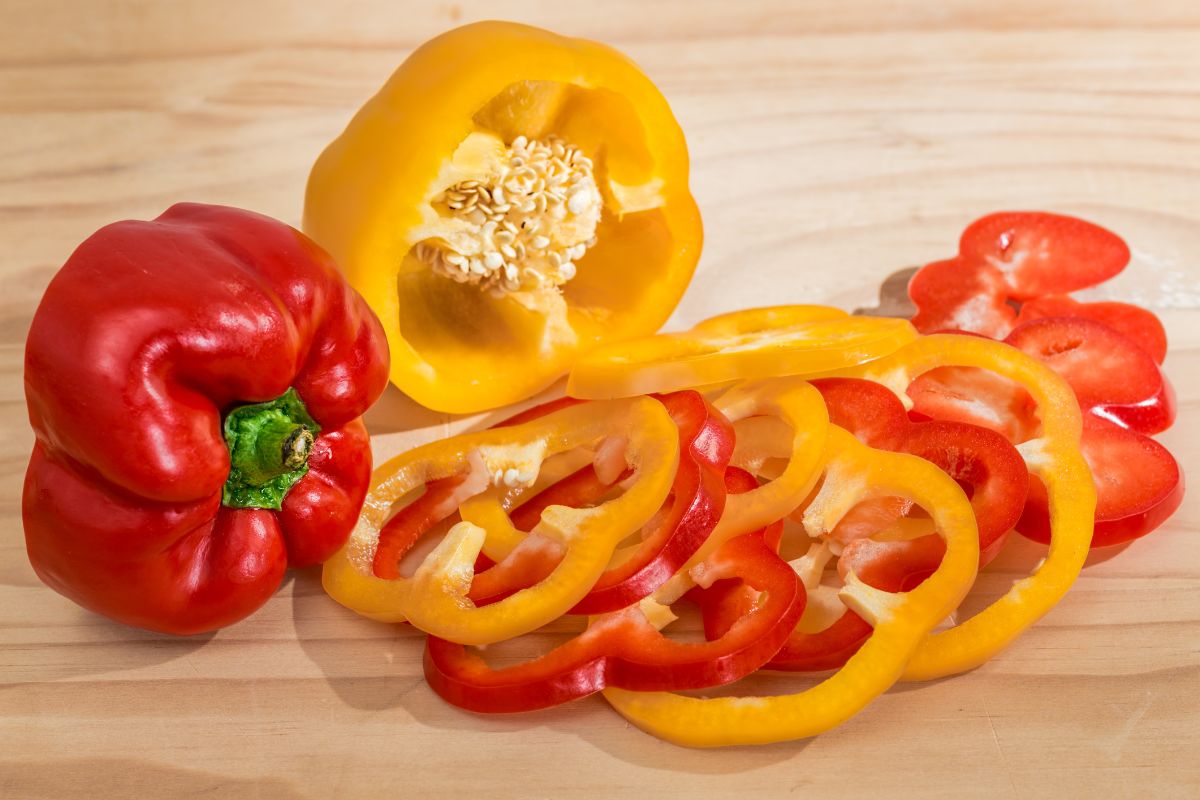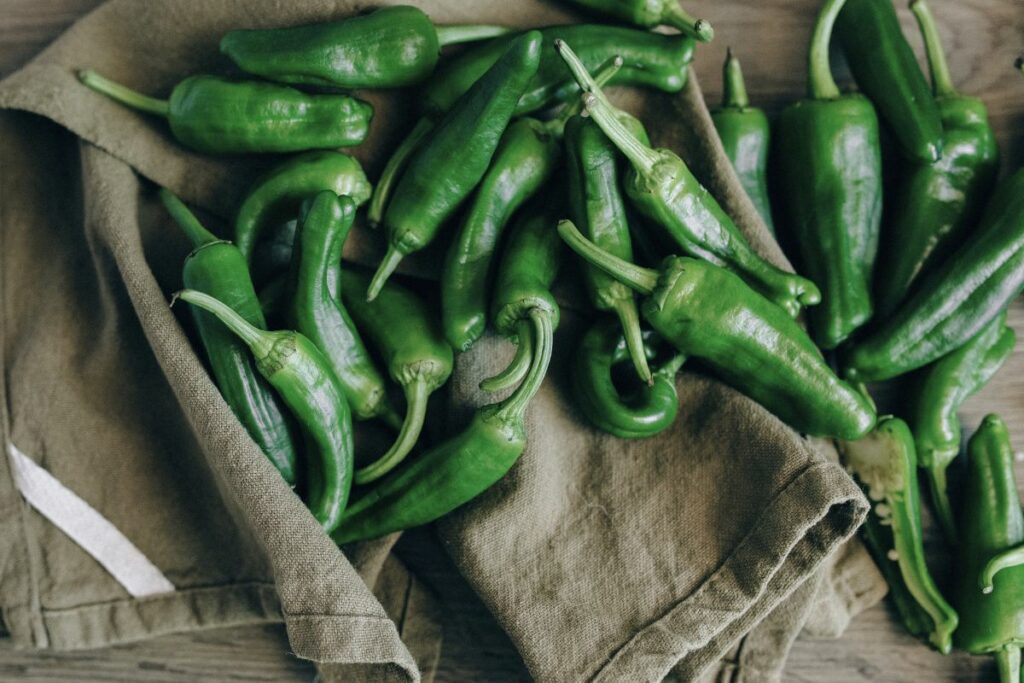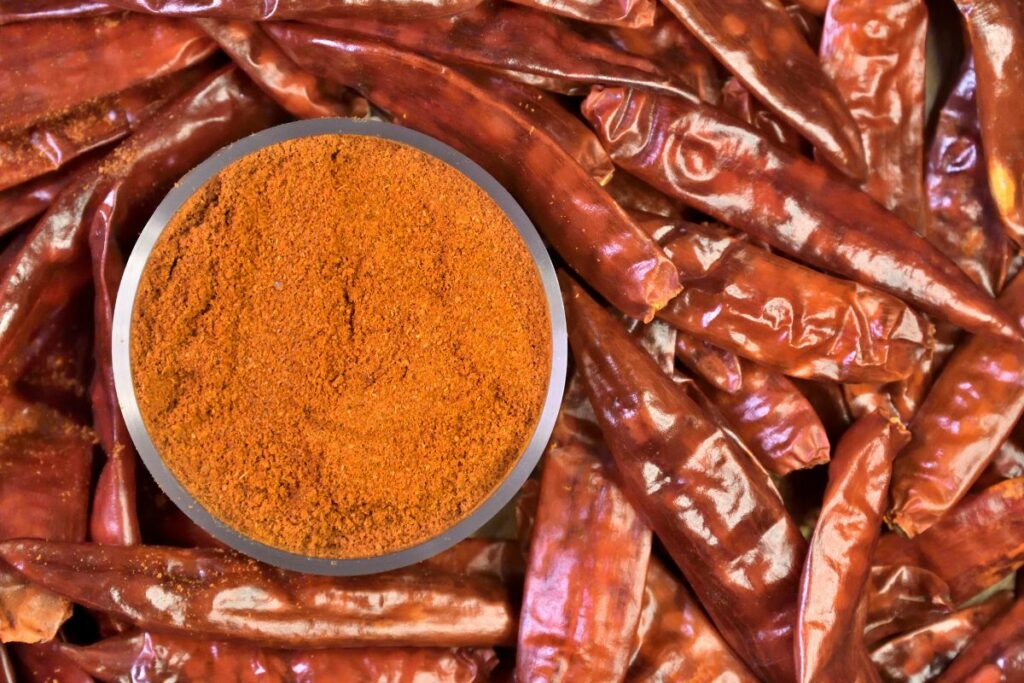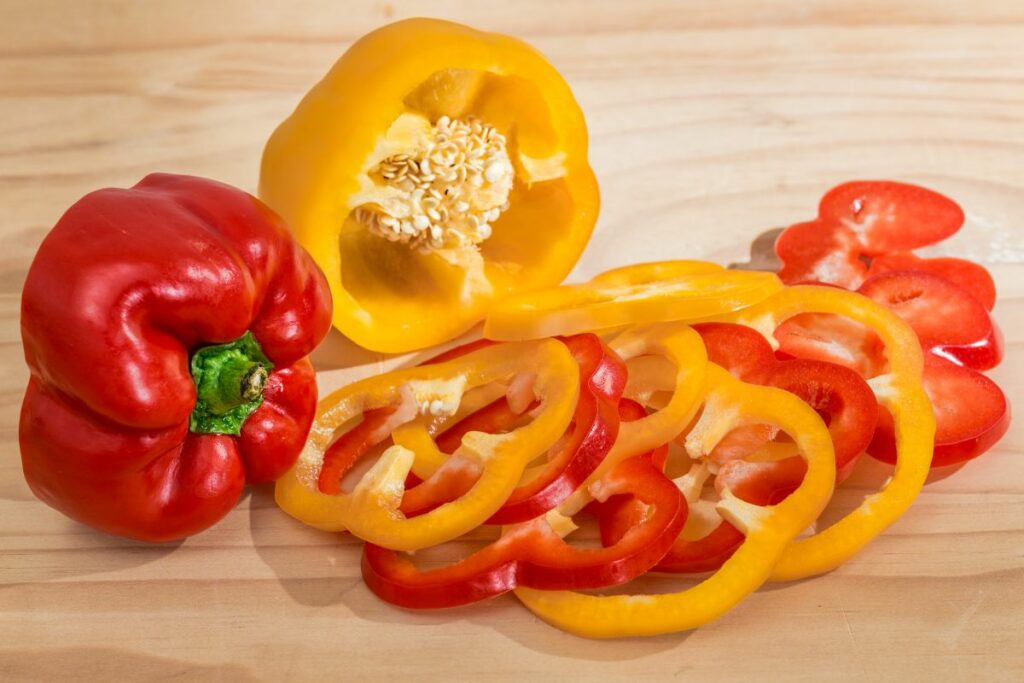Bell peppers are a versatile ingredient that can be used in countless recipes. However, some people may not be able to eat bell peppers due to allergies or personal preferences. In such cases, it is important to find a suitable substitute that can mimic the flavor and texture of bell peppers.
There are several options available for those looking to substitute bell peppers. Poblano, Cubanelle, and Anaheim peppers are some of the best options as they closely resemble the flavor and texture of bell peppers. While these substitutes may be slightly spicier than bell peppers, they are still mild and family-friendly. Other substitutes include onions, bok choy, and even spices, depending on the recipe. It is important to consider the role of bell peppers in the recipe and choose a substitute accordingly.

Contents
Understanding Bell Peppers
Bell peppers are a type of vegetable that come in three main colors: green, yellow, and red. They are known for their sweet taste and thick walls that make them perfect for stuffing. Bell peppers also have large internal cavities that make them ideal for slicing and dicing.
Bell peppers are a member of the Capsicum genus, which also includes chili peppers and jalapenos. They are not spicy like their cousins, but they do have a mild flavor that complements many dishes.
The color of a bell pepper depends on its level of ripeness. Green bell peppers are the least ripe and have a slightly bitter taste. Yellow bell peppers are more ripe and have a sweeter taste than green bell peppers. Red bell peppers are the most ripe and have the sweetest taste of all.
Bell peppers are a great source of vitamins and minerals. They are high in vitamin C, vitamin A, and potassium. They also contain fiber, which is important for digestive health.
In summary, bell peppers are a versatile and nutritious vegetable that come in a variety of colors and flavors. They have thick walls and large cavities that make them perfect for stuffing and slicing. Whether eaten raw or cooked, bell peppers are a tasty addition to any meal.
Common Bell Pepper Substitutes
Bell peppers are a popular ingredient in many dishes, but what if you don’t have any on hand or don’t like their taste? Fortunately, there are many common bell pepper substitutes that can be used in their place. Here are some of the best options:
Poblano Peppers
Poblano peppers are a great substitute for bell peppers in many recipes. They are similar in size and shape and have a mild flavor with a slightly sweet taste. They are also lower in heat than other pepper varieties, making them a good option for those who don’t like spicy food.
Anaheim Peppers
Anaheim peppers are another great substitute for bell peppers. They are slightly spicier than poblanos but still have a mild flavor. They are also similar in size and shape to bell peppers, making them a good substitute in recipes that call for diced or chopped bell peppers.

Cubanelle Peppers
Cubanelle peppers are a good substitute for bell peppers in recipes that call for a sweeter flavor. They have a thin skin and a slightly sweet taste, making them a good option for dishes like fajitas or stir-fries.
Jalapeno Peppers
Jalapeno peppers are a good substitute for bell peppers in recipes that call for a little bit of heat. They are slightly spicier than poblanos and anaheims but still have a mild flavor. They are also smaller in size, so you may need to use more of them to replace a bell pepper.
Banana Peppers
Banana peppers are a good substitute for bell peppers in recipes that call for a slightly tangy flavor. They have a thin skin and a slightly sweet taste, making them a good option for dishes like salads or sandwiches.
Pimiento Peppers
Pimiento peppers are a good substitute for bell peppers in recipes that call for a sweeter flavor. They are similar in size and shape to bell peppers and have a sweet, slightly smoky flavor.
Pepperoncini Peppers
Pepperoncini peppers are a good substitute for bell peppers in recipes that call for a slightly tangy flavor. They are similar in size and shape to banana peppers and have a slightly spicy, tangy flavor.
Sichuan Peppers
Sichuan peppers are a good substitute for bell peppers in recipes that call for a spicy flavor. They are similar in size and shape to bell peppers and have a slightly numbing, spicy flavor.

California Chili Peppers
California chili peppers are a good substitute for bell peppers in recipes that call for a slightly spicy flavor. They are similar in size and shape to bell peppers and have a slightly smoky, spicy flavor.
Cuban Peppers
Cuban peppers are a good substitute for bell peppers in recipes that call for a slightly sweet flavor. They are similar in size and shape to bell peppers and have a sweet, slightly spicy flavor.
Overall, there are many common bell pepper substitutes that can be used in a variety of recipes. Whether you prefer a mild or spicy flavor, there is a substitute that can work for you.
Factors to Consider When Choosing a Substitute
When looking for a substitute for bell peppers, there are several factors to consider in order to ensure that the substitute is the right fit for the recipe. Here are some important factors to keep in mind:
Flavor
Bell peppers have a mild, sweet flavor that is slightly earthy and fruity. When choosing a substitute, it’s important to consider the flavor of the substitute and how it will complement the other ingredients in the recipe. Some substitutes, like poblano peppers, have a similar flavor profile to bell peppers, while others, like banana peppers, have a sweeter flavor.
Texture
Bell peppers have a crunchy texture that holds up well when cooked. When choosing a substitute, it’s important to consider the texture of the substitute and how it will work in the recipe. Some substitutes, like cubanelle peppers, have a similar texture to bell peppers, while others, like Italian frying peppers, have a softer texture.

Mildness
Bell peppers are a relatively mild pepper with little to no spiciness. When choosing a substitute, it’s important to consider the spiciness of the substitute and how it will affect the overall flavor of the dish. Some substitutes, like Anaheim peppers, are slightly spicier than bell peppers, while others, like Italian frying peppers, have no spiciness at all.
Sweetness
Bell peppers have a slightly sweet flavor that is an important part of their overall taste profile. When choosing a substitute, it’s important to consider the sweetness of the substitute and how it will affect the overall flavor of the dish. Some substitutes, like banana peppers, have a sweeter flavor than bell peppers, while others, like poblano peppers, have a less sweet flavor.
Earthy Flavor
Bell peppers have a slightly earthy flavor that is an important part of their overall taste profile. When choosing a substitute, it’s important to consider the earthiness of the substitute and how it will affect the overall flavor of the dish. Some substitutes, like poblano peppers, have a similar earthy flavor to bell peppers, while others, like cubanelle peppers, have a less earthy flavor.
Peppery Flavor
Bell peppers have a slightly peppery flavor that is an important part of their overall taste profile. When choosing a substitute, it’s important to consider the peppery flavor of the substitute and how it will affect the overall flavor of the dish. Some substitutes, like Italian frying peppers, have a similar peppery flavor to bell peppers, while others, like Anaheim peppers, have a less peppery flavor.
By considering these factors, it’s possible to find a substitute for bell peppers that will work well in a recipe and provide a similar taste and texture profile.
Specific Bell Pepper Substitutes in Different Dishes
Bell peppers are a versatile ingredient that adds a unique flavor and texture to various dishes. However, if you don’t have bell peppers or want to try something different, there are several substitutes available. Here are some specific bell pepper substitutes that work well in different dishes:

Salads
If you’re making a salad that calls for bell peppers, you can use cubanelle peppers instead. Cubanelle peppers have a similar flavor to bell peppers but are slightly sweeter and milder. They also have thinner walls and a thinner skin, making them easier to chop and incorporate into salads.
Stuffing
Bell peppers are a popular ingredient in stuffing recipes, but if you’re looking for a substitute, you can use poblano peppers. Poblano peppers are slightly spicier than bell peppers but still have a mild flavor. They also have a similar shape and size, making them a suitable substitute for stuffing recipes.
Pizza
If you’re making a pizza and don’t have bell peppers, you can use banana peppers instead. Banana peppers are slightly sweeter and milder than bell peppers and have a similar texture. They also add a tangy flavor that pairs well with pizza toppings.
Stir-Fries
If you’re making a stir-fry that calls for bell peppers, you can use Anaheim peppers instead. Anaheim peppers are slightly spicier than bell peppers but still have a mild flavor. They also have a similar shape and size, making them a suitable substitute for stir-fry recipes.
Salsas
If you’re making a salsa and don’t have bell peppers, you can use jalapenos instead. Jalapenos are spicier than bell peppers, but they add a similar flavor and texture to salsas. They also add a kick of heat that pairs well with other salsa ingredients.
Casseroles
If you’re making a casserole that calls for bell peppers, you can use pepperoncini peppers instead. Pepperoncini peppers are slightly spicier than bell peppers but still have a mild flavor. They also add a tangy flavor that pairs well with other casserole ingredients.

Chili Beans
If you’re making chili beans and don’t have bell peppers, you can use poblano peppers instead. Poblano peppers are slightly spicier than bell peppers but still have a mild flavor. They also add a unique flavor that pairs well with other chili ingredients.
Overall, there are several bell pepper substitutes available that work well in different dishes. By using these substitutes, you can add a unique flavor and texture to your recipes and experiment with different ingredients.
Health Considerations
Bell peppers are a nutritious vegetable that provides a variety of health benefits. They are a good source of antioxidants, which help to protect the body from damage caused by harmful molecules called free radicals. Antioxidants have been linked to a reduced risk of chronic diseases such as heart disease, cancer, and Alzheimer’s disease.
However, some people may be allergic to bell peppers and experience symptoms such as itching, swelling, and difficulty breathing. In such cases, it is important to find a substitute that does not cause an allergic reaction. Some bell pepper substitutes that are safe for people with allergies include pimentos, roasted tomatoes, poblano peppers, jalapeno peppers, and celery.
In addition, some people may experience indigestion or other digestive issues after consuming bell peppers. This may be due to the high fiber content of the vegetable. If you experience digestive issues after consuming bell peppers, it is recommended to limit your intake or find a substitute that is easier to digest.
Despite the potential health benefits of bell peppers, it is important to note that they are not a complete source of all necessary nutrients. While they are a good source of vitamins A and C, they do not provide significant amounts of other essential nutrients such as iron and calcium. Therefore, it is recommended to consume a variety of nutrient-dense foods to ensure that all nutritional needs are met.
Overall, bell peppers can be a healthy addition to a balanced diet, but it is important to consider individual health needs and preferences when consuming them.
Availability and Usage
Bell peppers are a popular ingredient in many dishes, but for those who cannot or do not want to use them, there are several alternative options available. The availability of bell pepper substitutes may vary depending on the region and season, but many can be found in local grocery stores or farmers’ markets.
When choosing a bell pepper substitute, it is important to consider the flavor and texture of the original ingredient. Some substitutes, such as poblano or cubanelle peppers, closely mimic the taste and texture of bell peppers, while others, such as jalapenos or pepperoncinis, offer a spicier alternative. Pimiento peppers, on the other hand, are a sweet replacement for bell peppers.

For those who prefer a non-spicy pepper, frying peppers such as Italian frying peppers or banana peppers are mild and family-friendly options. Red bell pepper substitutes include sweet red peppers or roasted red peppers, which offer a similar flavor and color to the original ingredient.
Overall, the availability and usage of bell pepper substitutes provide a versatile and accessible option for those who cannot or choose not to use bell peppers in their cooking. By considering the flavor and texture of the original ingredient, individuals can find a substitute that best fits their needs and preferences.
Preparation Techniques
When it comes to preparing bell pepper substitutes, there are several techniques that can be used to achieve different flavors and textures. Some of the most popular preparation techniques include roasting, grilling, and preserving.
Roasting
Roasting bell pepper substitutes can add a smoky flavor to the dish. To roast bell peppers, cut them in half, remove the seeds and stem, and place them skin-side up on a baking sheet. Drizzle with olive oil and sprinkle with salt and pepper. Roast in the oven at 400°F for 20-25 minutes, until the skin is charred and the flesh is tender. Let cool, then peel off the skin.
Grilling
Grilling bell pepper substitutes can add a charred flavor to the dish. To grill bell peppers, cut them in half, remove the seeds and stem, and brush with olive oil. Grill over medium-high heat for 5-7 minutes per side, until the skin is charred and the flesh is tender. Let cool, then remove the skin.
Preserving
Preserving bell pepper substitutes can extend their shelf life and add a tangy flavor to the dish. To preserve bell peppers, cut them into strips and pack them into sterilized jars. In a saucepan, combine vinegar, water, sugar, salt, and spices, and bring to a boil. Pour the hot liquid over the peppers, leaving ½ inch of headspace. Seal the jars and process in a boiling water bath for 10 minutes.
Overall, these preparation techniques can help bring out the best in bell pepper substitutes and add depth of flavor to any dish.

Other Vegetable Substitutes
If you don’t have bell peppers available or want to try something different, there are other vegetables that can be used as substitutes in recipes. Here are some options:
- Broccoli: Broccoli can be used as a substitute for bell peppers in stir-fries or casseroles. It has a similar texture and can add a nice crunch to dishes.
- Green Onions: Green onions can be used as a substitute for bell peppers in salads or as a garnish. They add a mild onion flavor and a pop of color.
- Bok Choy: Bok choy can be used as a substitute for bell peppers in stir-fries or soups. It has a similar texture and adds a nice crunch to dishes.
- Zucchini: Zucchini can be used as a substitute for bell peppers in pasta dishes or casseroles. It has a mild flavor and a similar texture.
- Cucumber: Cucumber can be used as a substitute for bell peppers in salads or as a garnish. It adds a refreshing crunch and a mild flavor.
When using these vegetables as substitutes, it’s important to consider their flavor and texture. Some vegetables, like broccoli and bok choy, have a similar texture to bell peppers, while others, like cucumber, have a very different texture. It’s also important to consider the flavor of the vegetable and how it will complement the other flavors in the dish.
Overall, these vegetables can be great substitutes for bell peppers in certain dishes. Experiment with different options to find the best fit for your recipe.
